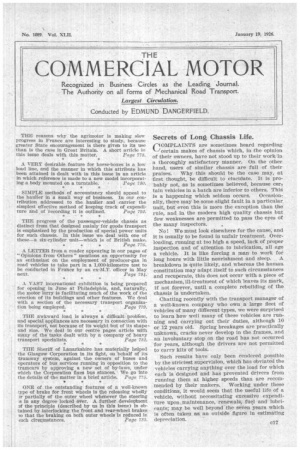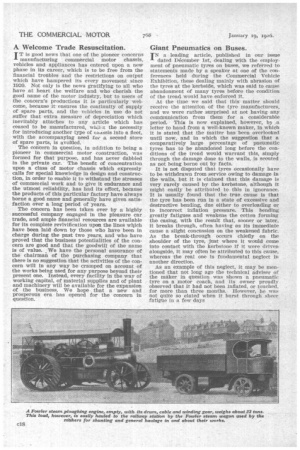Secrets of Long Chassis Life.
Page 1

Page 2

If you've noticed an error in this article please click here to report it so we can fix it.
C0MPLAINTS are sometimes heard regarding certain makes of chassis which, in the opinion of their owners, have not stood up to their work in a thoroughly satisfactory manner. On the other hand, users of similar chassis are full of their praises. Why this should be the ease may, at first thought, be difficult to elucidate. It is probably not, as is sometimes believed, because cer-a tain vehicles in a batch are inferior to others. Thin is a happening which seldom occurs. Occasions, ally, there may be some slight fault in a particular, unit, but even this is more the exception than the rule, and in the modern high quality chassis but few weaknesses are permitted to pass the eyes of the many inspectors.
No We. must look elsewhere for the cause, and it is usually to be found in unfair treatment. Overloading, running at too high a speed, lack of proper inspection and of attention to lubrication, all age a vehicle. It is like forcing a man to work for long hours with little nourishment and sleep. A breakdown is quite likely, and whereas the human constitution may adapt itself to such circumstances and recuperate, this does not occur with a piece of mechanism,. ill-treatment of which leaves its mark, if not forever, until a complete rebuilding of the chassis is undertaken.
Chatting recently with the transport manager of a well-known company who own a large fleet of vehicles of many different types, we were surprised to learn how well many of these vehicles are running and carrying out their duties, although 10 or 12 years old. Spring breakages are practically unknown, cracks never develop in the frames, and an involuntary stop on the road has not occurred for years, although the drivers are not permitted to carry kits of tools.
Such results have only been rendered possible by the strictest supervision, which has obviated the vehicles carrying anything over the load for which each is 'designed and has prevented drivers from running them at higher speeds than are recommended by their makers. Working under these conditions, it would seem that the useful life of a vehicle, without necessitating excessive expenditure upon ,maintenance, renewals, fuel and lubricants; may be well beyond the seven years which is often taken as an outside figure in estimating depreciation. oil
A Welcome Trade Resuscitation. Giant Pneumatics on Buses.
IT is good news that one of the pioneer concerns manufacturing commercial motor chassis, vehicles and appliances has entered upon a new phase in its career, which is to be free from the financial troubles and the restrictions on output which have hampered its every movement since 1920, Not only is the news gratifying to all who have at heart the welfare and who cherish the good name of the motor industry, but to users of the concern's productions it is particularly welcome, because it ensures the continuity of supply of spare parts, and the vehicles in use do not suffer that extra measure of depreciation which inevitably attaches to any article which has ceased to be manufactured, whiht the necessity for introducing another type of coassis into a fleet, with the accompanying need for a second store of spare parts, is avorded.
The concern in question, in addition to being a pioneer in commercial motor construction, was formed for that purpose, and has never dabbled in the private car. The benefit of concentratiou upon a class of motor chassis which expressly calls for special knowledge in design and construction, in order to enable it to withstand the stresses of commetcial work and to give it endurance and the utmost reliability, has had its effect, because the products of this particular factory have always borne a good name and generally have given satisfaction over a long period of years.
The concern has been taken over by a highly successful company engaged in the pleasure car trade, and ample financial resources are available for its complete revivification upon the lines which have been laid down by those who have been in charge during the past two years, and who have proved that the business potentialities of the concern are good and that the goodwill of the name is of value. We have the personal assurance of the chairman of the purchasing company that there is no suggestion that the activities of the concern will in any way be cramped on account of the works being used for any purpose beyond their present one. Instead, every facility in the way of working capital, of material supplies and of plant and machinery will be available for the expansion of the business. We hope that a new and prosperous era has opened for the concern in question. IN a leading article, published in our issue -adated December 1st, dealing with the employment of pneumatic tyres on buses, we referred to statements made by a speaker at one of the conferences held during the Commercial Vehicle Exhibition, these dealing mainly with abrasion of the tyres at the kerbside, which was said to cause abandonment of many tyres before the condition of the tread would have enforced it. .
At the time we said that this matter should receive the attention of the tyre manufacturers, and we were rather surprised at not having any communication from them for a considerable period. This Is now explained, however, by ;a letter to hand from a well-known maker, in which it is stated that the matter has been overlooked until now, and in which the suggestion that a comparatively large percentage of pneumatic tyres has to be abandoned long before the conditions of the tread would warrant this, simply through the damage done to the walls, is scouted as not being borne out by facts.
It Is not disputed that tyres occasionally have to be withdrawn from service owing to damage in the walls, but it is claimed that this damage is very rarely caused by the kerbstone, although it might easily be attributed to this in ignorance. It is usually found that the true cause is that the tyre has been run in a state of excessive and destructive bending, due either to overloading or to incorrect inflation pressure. This bending greatly fatigues and weakens the cotton forming the casing, with the result that, sooner or later, It breaks through, often having as its immediate cause a slight concussion on the weakened fabric. As the break-through occurs chiefly on the shoulder of the tyre, Just where it would come into contact with the kerbstone if it were driven alongside, it may often be attributed to this cause, whereas the real one is fundamental neglect in another direction.
As an example of this neglect, it may be mentioned that not long ago the technical adviser of the milker in question was shown a pneumatic tyre on a motor coach, and its owner proudly observed that it had not been inflated, or touched, for more than three months. However, he was not quite so elated when it burst through sheer fatigue in a few days






























